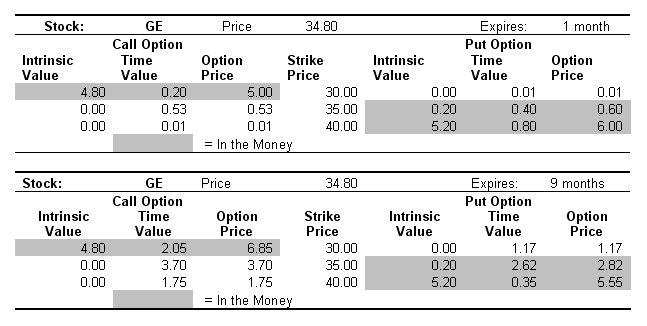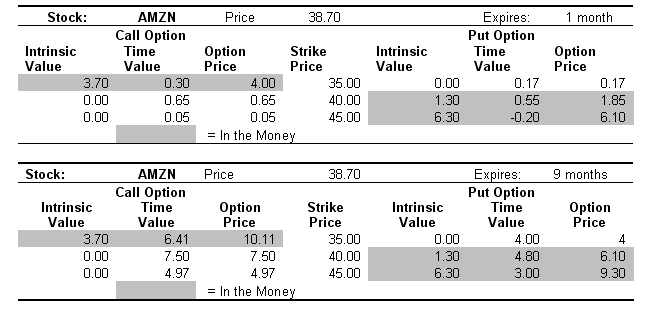You might have had success beating the market by trading stocks using a disciplined process that anticipates a nice move either up or down. Many traders have also gained the confidence to make money in the stock market by identifying one or two good stocks that may make a big move soon.
But if you don't know how to take advantage of that movement, you might be left in the dust. If this sounds like you, then maybe it's time to consider using options to play your next move. This article will explore some simple factors that you must consider if you plan to trade options to take advantage of stock movements.
Option Pricing
Before venturing into the world of trading options, investors should have a good understanding of the factors that determine the value of an option. These include the current stock price, the intrinsic value, time to expiration or the time value, volatility, interest rates and cash dividends paid.
There are several options pricing models that use these parameters to determine the fair market value of the option. Of these, the Black-Scholes model is the most widely used. In many ways, options are just like any other investment in that you need to understand what determines their price in order to use them to take advantage of moves the market.
Main Drivers of an Option's Price
Let's start with the primary drivers of the price of an option: current stock price, intrinsic value, time to expiration or time value, and volatility. The current stock price is fairly obvious. The movement of the price of the stock up or down has a direct - although not equal - effect on the price of the option.
As the price of a stock rises, the more likely the price of a call option will rise and the price of a put option will fall. If the stock price goes down, then the reverse will most likely happen to the price of the calls and puts.
Intrinsic Value
Intrinsic value is the value that any given option would have if it were exercised today. Basically, the intrinsic value is the amount by which the strike price of an option is in the money. It is the portion of an option's price that is not lost due to the passage of time. The following equations can be used to calculate the intrinsic value of a call or put option:
| Call Option Intrinsic Value = Underlying Stock's Current Price - Call Strike Price |
| Put Option Intrinsic Value = Put Strike Price - Underlying Stock's Current Price |
The intrinsic value of an option reflects the effective financial advantage that would result from the immediate exercise of that option. Basically, it is an option's minimum value. Options trading at the money or out of the money have no intrinsic value.
For example, let's say General Electric (GE) stock is selling at $34.80. The GE 30 call option would have an intrinsic value of $4.80 ($34.80 - $30 = $4.80) because the option holder can exercise his option to buy GE shares at $30 and then turn around and automatically sell them in the market for $34.80 - a profit of $4.80.
In a different example, the GE 35 call option would have an intrinsic value of zero ($34.80 - $35 = -$0.20) because the intrinsic value cannot be negative. It is also important to note that intrinsic value also works in the same way for a put option.
For example, a GE 30 put option would have an intrinsic value of zero ($30 - $34.80 = -$4.80) because the intrinsic value cannot be negative. On the other hand, a GE 35 put option would have an intrinsic value of $0.20 ($35 - $34.80 = $0.20).
Time Value
The time value of options is the amount by which the price of any option exceeds the intrinsic value. It is directly related to how much time an option has until it expires as well as the volatility of the stock. The formula for calculating the time value of an option is:
| Time Value = Option Price - Intrinsic Value |
The more time an option has until it expires, the greater the chance it will end up in the money. The time component of an option decays exponentially. The actual derivation of the time value of an option is a fairly complex equation. As a general rule, an option will lose one-third of its value during the first half of its life and two-thirds during the second half of its life.
This is an important concept for securities investors because the closer you get to expiration, the more of a move in the underlying security is needed to impact the price of the option. Time value is often referred to as extrinsic value.
Time value is basically the risk premium that the option seller requires to provide the option buyer the right to buy/sell the stock up to the date the option expires. It is like an insurance premium of the option; the higher the risk, the higher the cost to buy the option.
Looking again at the example from above, if GE is trading at $34.80 and the one-month to expiration GE 30 call option is trading at $5, the time value of the option is $0.20 ($5.00 - $4.80 = $0.20).
Meanwhile, with GE trading at $34.80, a GE 30 call option trading at $6.85 with nine months to expiration has a time value of $2.05. ($6.85 - $4.80 = $2.05). Notice that the intrinsic value is the same and all the difference in the price of the same strike price option is the time value.
An option's time value is also highly dependent on the volatility in that the market expects the stock will display up to expiration. For stocks where the market does not expect the stock to move much, the option's time value will be relatively low.
The opposite is true for more volatile stocks or those with a high beta, due primarily to the uncertainty of the price of the stock before the option expires. In the table below, you can see the GE example that has already been discussed. It shows the trading price of GE, several strike prices and the intrinsic and time values for the call and put options.
General Electric is considered a stock with low volatility with a beta of 0.49 for this example.
 |
| Investopedia.com (c ) 2009 |
| Figure 1: General Electric (GE) |
Amazon.com Inc. (AMZN) is a much more volatile stock with a beta of 3.47 (see Figure 2). Compare the GE 35 call option with nine months to expiration with the AMZN 40 call option with nine months to expiration. GE has only $0.20 to move up before it is at the money, while AMZN has $1.30 to move up before it is at the money.
The time value of these options is $3.70 for GE and $7.50 for AMZN, indicating a significant premium on the AMZN option due to the volatile nature of the AMZN stock.
 |
| Investopedia.com (c ) 2009 |
| Figure 2: Amazon.com (AMZN) |
This makes - an option seller of GE will not expect to get a substantial premium because the buyers do not expect the price of the stock to move significantly.
On the other hand, the seller of an AMZN option can expect to receive a higher premium due to the volatile nature of the AMZN stock. Basically, when the market believes a stock will be very volatile, the time value of the option rises.
On the other hand, when the market believes a stock will be less volatile, the time value of the option falls. It is this expectation by the market of a stock's future volatility that is key to the price of options.
The effect of volatility is mostly subjective and it is difficult to quantify. Fortunately, there are several calculators that can be used to help estimate volatility. To make this even more interesting, there are also several types of volatility - with implied and historical being the most noted.
When investors look at the volatility in the past, it is called either historical volatility or statistical volatility. Historical Volatility helps you determine the possible magnitude of future moves of the underlying stock. Statistically, two-thirds of all occurrences of a stock price will happen within plus or minus one standard deviation of the stocks' move over a set time period.
Historical volatility looks back in time to show how volatile the market has been. This helps options investors to determine which exercise price is most appropriate to choose for the particular strategy they have in mind.
Implied volatility is what is implied by the current market prices and is used with the theoretical models. It helps to set the current price of an existing option and assists option players to assess the potential of an option trade. Implied volatility measures what option traders expect future volatility will be.
As such, implied volatility is an indicator of the current sentiment of the market. This sentiment will be reflected in the price of the options helping options traders to assess the future volatility of the option and the stock based on current option prices.
The Bottom Line
A stock investor who is interested in using options to capture a potential move in a stock must understand how options are priced. Besides the underlying price of the stock, the key determinates of the price of an option are its intrinsic value - the amount by which the strike price of an option is in-the-money - and its time value.
Time value is related to how much time an option has until it expires and the option's volatility. Volatility is of particular interest to a stock trader wishing to use options to gain an added advantage. Historical volatility provides the investor a relative perspective of how volatility impacts options prices, while current option pricing provides the implied volatility that the market currently expects in the future.
Knowing the current and expected volatility that is in the price of an option is essential for any investor that wants to take advantage of the movement of a stock's price.
As a long time investor, Hans Wagner was able to retire at 55 by following a disciplined process using sound investment principles. After his children and their friends graduated from college, Hans began helping them to invest in the stock market. Soon, friends and acquaintances also began to seek advice, so Hans created a website, Trading Online Markets, which provides information on investing topics, along with sample portfolios that consistently beat the market.







 © 2025
© 2025